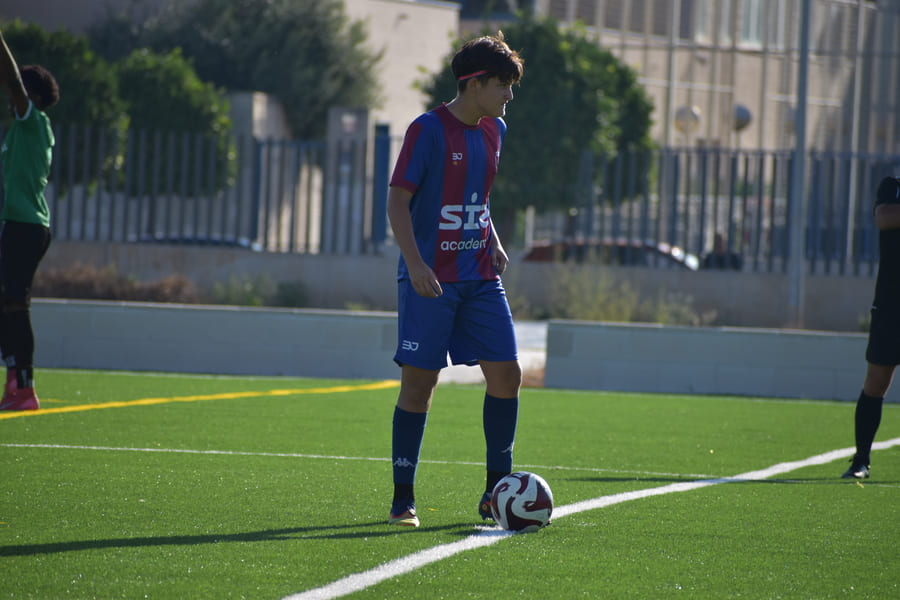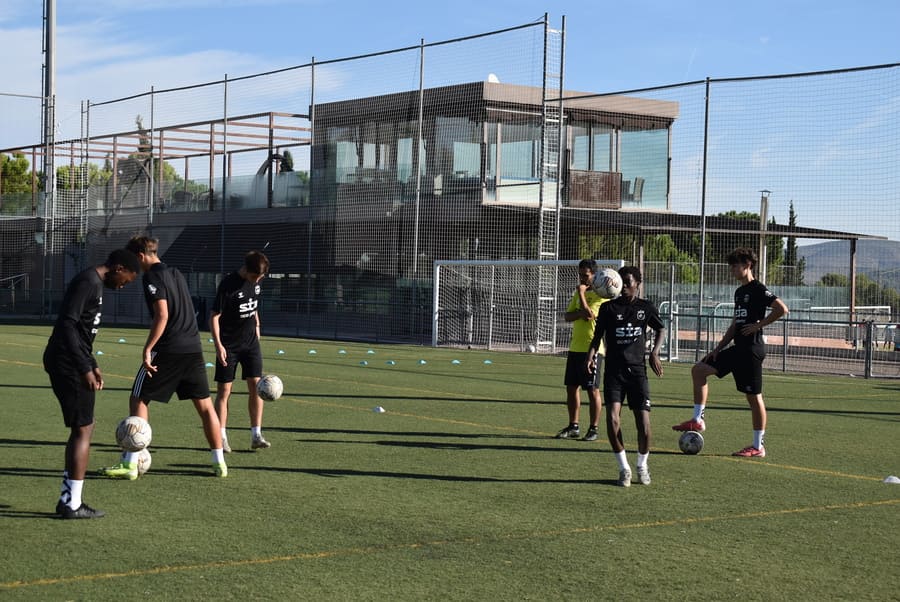At SIA Academy, we believe that success is not only measured by goals or victories, but also by the ability to stay healthy, consistent, and available for every training session. Injury prevention is, without a doubt, one of the pillars on which we build our daily training philosophy. In intense workouts, where physical limits are constantly tested, taking care of the body is a form of athletic intelligence.
Our physical coach Ximo sums it up perfectly: “A strong player isn’t the one who trains the most, but the one who takes the best care of themselves before and after effort.” Guided by this philosophy, we’ve designed a comprehensive approach that combines science, discipline, and personalized attention. In this article, we share our top 7 key tips for preventing muscle injuries, drawn from our daily experience with high-performance athletes and young talents striving to reach their full potential.
Table of contents
1. Smart warm-up: the key to avoid injuries
Every prevention process begins with proper activation. A correct warm-up prepares the body and mind to perform at their best without risk. At SIA Academy, we never start a session without a progressive warm-up protocol, which includes joint mobility, cardiovascular activation, and sport-specific drills.
The goal is to wake up the muscles, lubricate the joints, and enhance neuromuscular coordination. This step drastically reduces the risk of strains or pulls. As Ximo says, “Rushing into training without preparing your body is the first step toward an avoidable injury.” It’s not just about moving — it’s about educating the body for the effort ahead.

2. Cooling down and active recovery: closing the prevention cycle
Cooling down is just as important as warming up. Many athletes forget that the end of training is just as relevant as the beginning. Cooling down helps eliminate toxins, relax the muscles, and promotes recovery, which directly translates into long-term prevention.
At SIA Academy, our players end each session with guided stretches, breathing techniques, and mobility work. During high-intensity phases, we also include active recovery and regeneration sessions such as pool work or cryotherapy. This approach helps the body stay balanced and prevents accumulated muscle fatigue.
3. Listen to your body: the best prevention tool
No technology can replace the sensitivity of your own body. In our experience, athletes who learn to listen to their sensations get injured less and progress faster. Prevention doesn’t depend only on the physical coach — it also relies on the athlete’s awareness.
The body usually warns before an injury: discomfort, stiffness, or unusual fatigue are warning signs. At SIA Academy, we encourage an open communication culture where players report any issue before it becomes a bigger problem. Ximo emphasizes: “There’s no such thing as an injury without warning; there’s only the warning that went ignored.”
4. Nutrition and rest: invisible prevention
Prevention doesn’t end when training does. Muscles strengthen during rest and recovery, not during effort. That’s why balanced nutrition and proper sleep are just as important as the workout itself.
At SIA Academy, we work with sports nutrition specialists who tailor each player’s diet to their needs. The goal is to promote muscle regeneration and keep the body ready for the next challenge. Likewise, we insist on at least eight hours of sleep each night since deep rest boosts hormone production essential for tissue repair.
Good nutrition and sufficient rest are silent yet powerful prevention tools.
5. Functional strength training: the foundation of a resilient body
In modern football — and any high-performance sport — strength means prevention. But it’s not just about lifting weights: functional strength training means preparing the body to move with control, stability, and efficiency.
At SIA Academy, we design position-specific routines that combine core, stability, and power exercises. Our goal isn’t just to increase raw strength but to improve coordination between muscles and joints, reducing the likelihood of imbalances or overuse injuries.
As Ximo wisely says, “A balanced body resists more, responds better, and recovers faster.” That’s the essence of effective prevention.

6. Load management and progressive training: the science of prevention
One of the most common mistakes, especially among young athletes, is increasing training intensity or volume too quickly. At SIA Academy, we apply a methodology based on load management and gradual progression.
Using monitoring tools, we adjust each player’s training intensity according to their physical response. This way, we avoid overtraining, one of the main causes of muscle injuries. Scientific prevention not only protects athletes but also optimizes their long-term performance.
7. Hydration and healthy habits: the simplest and most overlooked prevention
It might seem basic, but proper hydration is one of the most effective forms of prevention. Dehydration directly affects muscle contraction and can lead to cramps or premature fatigue.
At SIA Academy, we insist that the water bottle is just as important as the boots or the ball. Players receive personalized hydration guidelines before, during, and after training. We also promote healthy habits off the field: avoiding alcohol, maintaining good sleep hygiene, and respecting recovery times.
Prevention as a champion’s mindset
An athlete’s true strength isn’t measured only by performance but by their ability to stay healthy and available. At SIA Academy, we see prevention as a mindset, a work ethic, and a lifestyle. Every warm-up, every stretch, every hour of rest, and every daily decision contributes to the same goal: train hard, but don’t break.
As Ximo concludes, “The greatest victory isn’t just winning matches, but staying fit to play them.” That is, without doubt, the true essence of prevention — taking care today of the body that will allow us to perform tomorrow.






